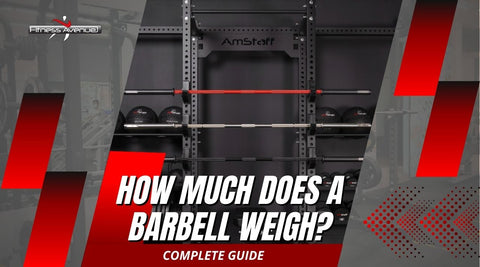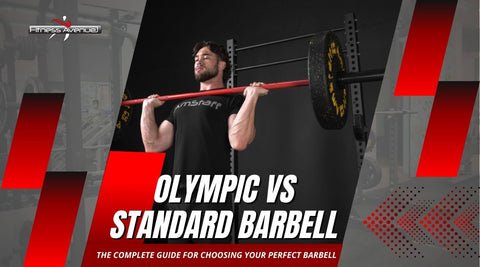Barbells may look simple, but their weight plays a significant role in training that most people overlook. Knowing barbell weight is crucial for proper workout planning, tracking progress, and ensuring safety during strength training. So, how much does a barbell weigh?
The answer isn’t always straightforward. While the standard Olympic bar typically weighs 45 pounds, lighter and heavier variations are available for different lifters and specific exercises. Whether you're setting up a home gym, starting your fitness journey, or looking to upgrade your equipment, understanding these differences will help you make informed decisions and achieve better results.
What Is The Weight Of A Barbell?

The weight of a barbell depends entirely on its type and intended use. Standard Olympic barbells for men weigh 45 pounds (20 kg), while women's Olympic barbells weigh 33 pounds (15 kg). However, the fitness equipment landscape includes numerous specialty bars with different weights designed for specific training applications.
Understanding these weight variations becomes essential when calculating your total lifted weight, planning progressive overload, and selecting appropriate equipment for your strength level. The standardization of barbell weight ensures consistency across commercial gyms and competitions worldwide, making it easier to track progress regardless of where you train.
Common Types of Barbells and Their Weights
Olympic Barbells

Olympic bars represent the gold standard in strength training equipment. Men's Olympic bars consistently weigh 45 pounds (20 kg) and measure 7 feet in total length with a 28mm shaft diameter. These barbells feature rotating sleeves with either needle bearings or bronze bushings, allowing smooth plate rotation during dynamic Olympic lifts.
Women's Olympic barbells weigh 33 pounds (15 kg) and feature a thinner 25mm shaft diameter designed for smaller hands. The reduced weight and diameter make women's bars ideal for beginners, regardless of gender, as they provide better grip security and are less intimidating for those starting their strength training journey.
Our Yukon Bar 15kg exemplifies high-quality Olympic barbell construction, featuring a 25mm shaft diameter, a composite bushing system, and medium volcano knurling. This versatile barbell works perfectly for mixed-use training, combining powerlifting and Olympic weightlifting capabilities in one high-quality package.
Powerlifting Barbells
Powerlifting barbells typically weigh 45 pounds (20 kg) but feature distinct design characteristics that optimize them for maximum strength training. These barbells have slightly thicker 29mm shaft diameters, more aggressive knurling patterns, and minimal flex to provide stability during heavy compound movements.
The increased shaft diameter reduces bar deflection under heavy loads, allowing for more precise control during maximum efforts. Many powerlifting barbells include center knurling for improved stability during back squats, distinguishing them from their Olympic counterparts.
Deadlift Bar
The deadlift bar maintains a standard 45-pound (20 kg) weight while incorporating specialized design features for pulling movements. These barbells typically measure longer than standard barbells at approximately 7 feet 4 inches and feature thinner 27mm shaft diameters.
The reduced diameter improves grip security, particularly beneficial for lifters with smaller hands. The increased length allows for more bar flex or "whip," which can provide a mechanical advantage during the initial pull phase by reducing the breaking force required to start the movement. Read the complete guide about the best deadlift bar options in Canada.
Squat Bar
Squat bars represent some of the heaviest standard barbells, typically weighing 55 pounds (25 kg) due to their reinforced construction and extended length. These specialized barbells feature thicker 32mm shaft diameters, providing maximum rigidity and minimal flex.
The increased rigidity proves essential during heavy squats, where any bar oscillation can disrupt balance and timing. Many squat bars feature continuous knurling across the grip area, without center smooth sections, providing a consistent texture for hand placement and back contact. Our Samson Squat Bar exemplifies this specialized construction with its reinforced design built specifically for heavy squatting applications.
EZ Curl Bar
The EZ curl bar offers a lighter alternative for isolation exercises, typically weighing 10 kg (22 pounds). The distinctive W-shaped design reduces wrist stress during curling movements while maintaining effective muscle activation for bicep curls.
These specialty bars prioritize ergonomic comfort over heavy loading capacity, making them excellent choices for high-repetition training and rehabilitation applications.
Tricep Bars
Tricep bars maintain similar weights to EZ bar at approximately 22 pounds, featuring parallel grip positions that reduce wrist stress during pressing movements. The simpler construction compared to EZ bars often results in more consistent weight specifications across manufacturers.
Why Barbell Weights Matter

Understanding barbell weights proves crucial for several important reasons that directly impact your training success and safety. Accurate weight tracking enables proper progressive overload, the fundamental principle underlying strength development and muscle growth.
Progress Tracking and Goal Setting
Knowing your barbell's exact weight enables the precise calculation of the total weight lifted, allowing for accurate progress tracking over time. This precision becomes particularly important when following structured training programs that prescribe specific weight increases and percentage-based loading schemes.
The ability to track incremental progress provides motivation and objective feedback about training effectiveness. Without accurate baseline weights, it becomes impossible to determine whether strength gains are occurring or if adjustments to the programming are necessary.
Safety and Proper Loading
Understanding barbell weights is crucial for selecting an appropriate load that aligns with individual strength levels and training experience. Beginning with excessively heavy weights can lead to improper form breakdown, increased injury risk, and discouragement from continuing to participate in training.
Many beginners struggle to initially handle the 45-pound Olympic barbell for upper-body exercises like bench presses or overhead presses, making lighter alternatives essential for safe skill development. Our selection includes lighter training bar options that facilitate proper form learning without compromising safety.
Equipment Investment Decisions
Knowing the weight differences between different types of barbells helps inform equipment purchase decisions based on training goals and available space. Home gym enthusiasts can select appropriate barbells that provide optimal functionality within their specific requirements and budgets.
Investing in quality barbells pays dividends through improved training outcomes, enhanced durability, and a better user experience over the long term, thanks to consistent use.
How to Identify Barbell Weight Without a Scale
Several reliable methods exist for identifying bar weight when scales are unavailable, utilizing physical characteristics and design features as identification cues.
Physical Dimensions and Shaft Diameter
Shaft diameter provides one of the most reliable identification characteristics. Men's Olympic barbells feature a 28mm diameter, while women's versions use a 25mm diameter. Powerlifting barbells typically measure 29mm, while standard barbells maintain a diameter of 25mm throughout their length.
These diameter differences create distinct grip feels that experienced lifters recognize immediately. The thicker powerlifting bar diameters provide more substantial grips, while thinner diameters offer enhanced grip security for smaller hands.
Knurling Patterns and Markings
Knurling depth and pattern provide visual and tactile identification cues. Olympic barbells typically feature moderate knurling without center sections, whereas powerlifting barbells often include aggressive knurling with center sections to enhance squat stability.
Grip markings offer another identification method. Olympic barbells display markings 36 inches apart for competition compliance, while powerlifting barbells feature 32-inch spacing. Multi grip bar may include both marking sets.
Length and Sleeve Characteristics
Barbell length varies between types, with most barbells measuring 7 feet for Olympic and powerlifting versions, deadlift bars extending to 7 feet 4 inches, and some squat bars reaching 8 feet in length. These length differences become apparent when comparing barbells side by side.
Sleeve rotation quality also indicates the type and quality level of the barbell. Olympic barbells require smooth-rotating sleeves for dynamic movements, while powerlifting barbells utilize controlled rotation systems. Standard barbells often lack rotating sleeves entirely.
Tips for Choosing the Right Barbell
Selecting the optimal barbell requires consideration of multiple factors, including training experience, goals, available space, and budget constraints.
Assess Your Current Strength Level
Beginners should prioritize a lighter bar that facilitates proper form development without overwhelming strength requirements. The 33-pound women's barbell or specialized training bars provide excellent starting points regardless of gender.
Our Revelstoke Weightlifting Bar, 15kg, offers IWF specifications with a hybrid needle-bearing system, making it perfect for those learning Olympic-style lifts or preferring lighter weight options.
Consider Your Training Goals
Strength training routines favor powerlifting barbells with aggressive knurling and minimal flex, while dynamic Olympic lifts benefit from bars with appropriate whip characteristics and smooth rotation. General fitness practitioners often prefer multi-purpose barbells that accommodate a range of training modalities and various muscle groups.
Evaluate Your Space and Environment
Home gym environments may favor shorter barbells or women's specifications due to space limitations and ceiling height restrictions. Consider storage requirements and climate control when selecting surface treatments and coatings for lifting weights.
Budget and Long-term Investment
Quality barbells represent long-term investments that can provide decades of reliable service. While specialty bars offer optimal performance for specific applications, versatile multi-purpose options provide cost-effective solutions for general fitness needs.
We offer competitively priced options across all barbell categories, ensuring you can find quality equipment that fits your budget while meeting performance requirements.
Also read: Olympic vs Standard Barbell
FAQs
Why are women's barbells lighter?
Women's barbells weigh 33 pounds instead of 45 pounds because they're specifically engineered to accommodate the physiological differences between male and female athletes. The lighter weight, combined with a thinner 25mm shaft diameter, provides better grip security for smaller hands and allows proper technique development without overwhelming strength requirements. This design optimization recognizes that effective training depends on matching equipment characteristics to user capabilities rather than forcing all users to adapt to a single standard barbell weight or other types of straight bars.
How much does a women's Olympic bar weigh?
A woman's olympic barbell weight is exactly 33 pounds or 15 kilograms. This standardized weight is maintained across all IWF-certified barbells and represents the international standard for women's weightlifting competitions. The consistency of this weight specification ensures accurate competition results and enables precise progress tracking across different training environments and equipment manufacturers.
Is a barbell better than dumbbells?
Barbells and dumbbells serve different training purposes, making the "better" choice dependent on specific goals and applications. Barbells excel for compound movements, progressive overload, and maximum strength development due to their stability and heavy loading capacity. Dumbbells offer superior unilateral training with neutral grip options, facilitating the correction of muscle imbalances and enhancing the range of motion in certain exercises. Most comprehensive training programs benefit from incorporating both free weights to maximize training benefits, whether using a trap bar, hex bar, or traditional straight bars.
Why do Olympic barbells bend?
Olympic barbells are designed to flex or "whip" under load, providing mechanical advantages during Olympic weightlifting movements. This controlled flexibility allows the bar to bend during explosive lifts, such as snatches and clean & jerks, creating momentum that assists in successful lift completion. The amount of whip is carefully engineered to optimize performance while maintaining structural integrity. This contrasts with traditional barbells, which minimize flex to provide stability during slower, controlled movements, such as the curl bar weights.
Are barbells the same weight worldwide?
Yes, competition-grade barbells maintain standardized weights worldwide according to international federation specifications. Men's Olympic barbells weigh 20 kg (44 pounds) and women's Olympic barbells weigh 15 kg (33 pounds) regardless of manufacturer or location. This standardization ensures fair competition and consistent training experiences. However, training barbells and specialty bars may vary in design between manufacturers, making weight verification crucial when switching between different equipment.
How can I tell if my barbell is 45 or 33 pounds without weighing it?
The most reliable identification method involves measuring the diameter of the shaft. Men's 45-pound barbells feature 28mm shaft diameters, while women's 33-pound barbells use 25mm diameters. You can also check the overall length - men's bars measure 7.2 feet while women's bars are typically 6.5-6.9 feet. Additionally, examine the knurl markings: men's barbells have grip marks 36 inches apart, while women's bars may have slightly closer spacing. The visual comparison with other known barbells also provides quick identification.
In Summary
A clear understanding of barbell weight is essential for ensuring proper training progress and informed equipment selection. Men's Olympic barbells weigh 45 pounds, while women's Olympic barbells weigh 33 pounds. Various specialty barbells offer different weights for specific applications.
The key takeaways include recognizing that the weight a barbell weighs varies by type and intended use, with Olympic, powerlifting, deadlift, and specialty barbells each serving distinct training purposes. Physical identification characteristics, such as shaft diameter, length, and knurling patterns, provide reliable methods for determining barbell specifications without the use of scales.
Proper barbell selection depends on matching equipment characteristics to individual strength levels, training goals, and environmental requirements. Beginners benefit from lighter barbells that facilitate form development, while advanced practitioners may require specialized equipment for optimal performance.
At Fitness Avenue, we offer a comprehensive selection of quality barbells designed to meet diverse training needs and budgets. Our competitive pricing and fast shipping to Canada and the US ensure you can access the right equipment for your strength training journey. Whether you're building a home gym or upgrading existing equipment, understanding barbell weights helps you make informed decisions that support long-term training success.
Citations:
[1] https://www.setforset.com/blogs/news/barbell-weight-size
[2] https://barbell-logic.com/barbell-hunting-101/



